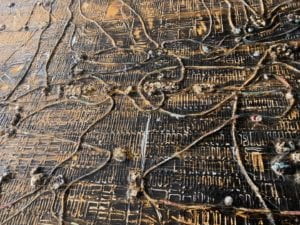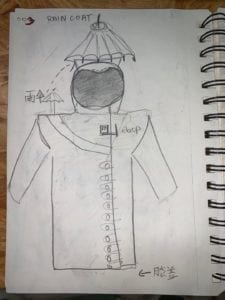Name: Eva Solo
Date: 09/10/19
Professor: Marcela Godoy
” 塑料是我的保护 ” (Sùliào shì wǒ de bǎohù) – Plastic is My Protection
[brief starting statement: Continuing the conversation with 余, as well as observing other trash collector in my complex, I drew the link between plastic as a raw material (that we discard) and the financial stability it provides during their second lifetime in the hands of the workers. On the most simplified level: I want to utilise plastic to create a big coat in the symbolism of protection.]
In the article Why good design comes from bad design the quotation “I don’t know what a good idea looks like until I’ve seen the bad ones” could have come at a better time. When I began considering my Trash Wearable I quickly was drawn to one specific way of designing the item, and then I read the article – just like the narrator emphasised polishing his best candidate for their pitch – I too realised I’m a few dozen trail design ideas away from my final product (witch, of course, will continue to evolve in the production stages). I took my initial inspiration and began ideating further. I jotted down as many ideas as I could brainstorm on paper, no mater how ridiculous or ‘impossible’ they seemed. The point of this step was to break the walls of my comfort and potentially come up with something I have not considered ever before.
This is that page:
I recently was able to visit the Long Museum and see Mark Bradford’s exhibition. He uses paper-mache to create very large scale pieces that are his response to the society he embraces. The commentary conveyed the extent personal association to his life, and I could really feel the emotions he was portraying. This further lead me to dive deeper in to the questions “What does this represent for me? / What do I want the users to take away from the viewing? / How does this fit into my community (neighbourhood, school, peers) ”
I was especially drawn to the texture and colour scheme for this piece, and will be drawing inspiration on the aesthetics in my midterm project.
Taking the advice from Why good design comes from bad design I sketched out an array of different possibilities drawing from my brainstorming page:
From the text Design Is The Problem, I spotted the quotation “Consumers often rely on assumptions that companies they trust—especially, large, known companies—wouldn’t sell such goods, but this assumption is often a mistake” and realised that I myself fall into this category. How much research do I do before I make an online purchase? Or an impulse one at the store? As stated in the text different communities value vary different priorities, especially when it comes to consumption. Are we to blame for the society we have been born to? I would say no, but we are responsible how we chose to behave which very much involves the funding of large corporations trying to milk our money. We cannot take the financial factor out of the equations no matter how hard we try, which means the approach needs to be changed towards the idea of sustainability, spreading awareness, and most importantly consumption. It is unlikely for the whole world to change over night, but for those with the knowledge setting an example is the least we can do. Learning how media, NGOs, stakeholders, and trade associations all fit into the environmental conversation is a new concept for me and still seems slightly complex to fully grasp. It is easy to go from one extreme to another (taking me as an example: not knowing anything and behaving purely out of instinct when consuming and discarding / and now feeling very strongly about where I spend my money and how I discard my waste ) but I really liked the idea of balance that was brought up in the reading. I think this concept can apply to individual approach also, I would not expect a very wasteful person to suddenly become sustainable, but taking small steps every day, every week, every month could formulate new habits and in turn influence the immediate circle of that particular individual. I have seen how my subtle efforts around the apartment has influenced my flatmates to also place their cans separately, turn lights off in the vacant rooms, and one of them actually started using a reusable water bottle. I think this was successful because I was not aggressive, but genuinely shared my new approach to little change, and how that not only affects me but ur shared world as well.























Leave a Reply